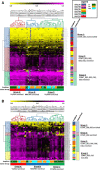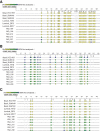Comprehensive interrogation of CpG island methylation in the gene encoding COMT, a key estrogen and catecholamine regulator
- PMID: 24460628
- PMCID: PMC3910242
- DOI: 10.1186/1755-8794-7-5
Comprehensive interrogation of CpG island methylation in the gene encoding COMT, a key estrogen and catecholamine regulator
Abstract
Background: The catechol-O-methyltransferase (COMT) enzyme has been widely studied due to its multiple roles in neurological functioning, estrogen biology, and methylation metabolic pathways. Numerous studies have investigated variation in the large COMT gene, with the majority focusing on single nucleotide polymorphisms (SNPs). This body of work has linked COMT genetic variation with a vast array of conditions, including several neurobehavioral disorders, pain sensitivity, and multiple human cancers. Based on COMT's numerous biological roles and recent studies suggesting that methylation of the COMT gene impacts COMT gene expression, we comprehensively interrogated methylation in over 200 CpG dinucleotide sequences spanning the length of the COMT gene.
Methods: Using saliva-derived DNA from a non-clinical sample of human subjects, we tested for associations between COMT CpG methylation and factors reported to interact with COMT genetic effects, including demographic factors and alcohol use. Finally, we tested associations between COMT CpG methylation state and COMT gene expression in breast cancer cell lines. We interrogated >200 CpGs in 13 amplicons spanning the 5' UTR to the last exon of the CpG dinucleotide-rich COMT gene in n = 48 subjects, n = 11 cell lines and 1 endogenous 18S rRNA control.
Results: With the exception of the CpG island in the 5'UTR and 1st exon, all other CpG islands were strongly methylated with typical dynamic ranges between 50-90%. In the saliva samples, methylation of multiple COMT loci was associated with socioeconomic status or ethnicity. We found associations between methylation at numerous loci and genotype at the functional Val158Met SNP (rs4680), and most of the correlations between methylation and demographic and alcohol use factors were Val158Met allele-specific. Methylation at several of these loci also associated with COMT gene expression in breast cancer cell lines.
Conclusions: We report the first comprehensive interrogation of COMT methylation. We corroborate previous findings of variation in COMT methylation with gene expression and the Val158Met genotype, and also report novel associations with socioeconomic status (SES) and ethnicity at several methylated loci. These results point to novel mechanisms for COMT regulation, which may have broad therapeutic implications.
Figures



References
-
- Mannisto PT, Kaakkola S. Catechol-O-methyltransferase (COMT): biochemistry, molecular biology, pharmacology, and clinical efficacy of the new selective COMT inhibitors. Pharmacol Rev. 1999;7:593–628. - PubMed
-
- Lavigne JA, Helzlsouer KJ, Huang HY, Strickland PT, Bell DA, Selmin O, Watson MA, Hoffman S, Comstock GW, Yager JD. An association between the allele coding for a low activity variant of catechol-O-methyltransferase and the risk for breast cancer. Cancer Res. 1997;7:5493–5497. - PubMed
-
- Diatchenko L, Slade GD, Nackley AG, Bhalang K, Sigurdsson A, Belfer I, Goldman D, Xu K, Shabalina SA, Shagin D. et al.Genetic basis for individual variations in pain perception and the development of a chronic pain condition. Hum Mol Genet. 2005;7:135–143. - PubMed
Publication types
MeSH terms
Substances
Grants and funding
LinkOut - more resources
Full Text Sources
Other Literature Sources
Miscellaneous

